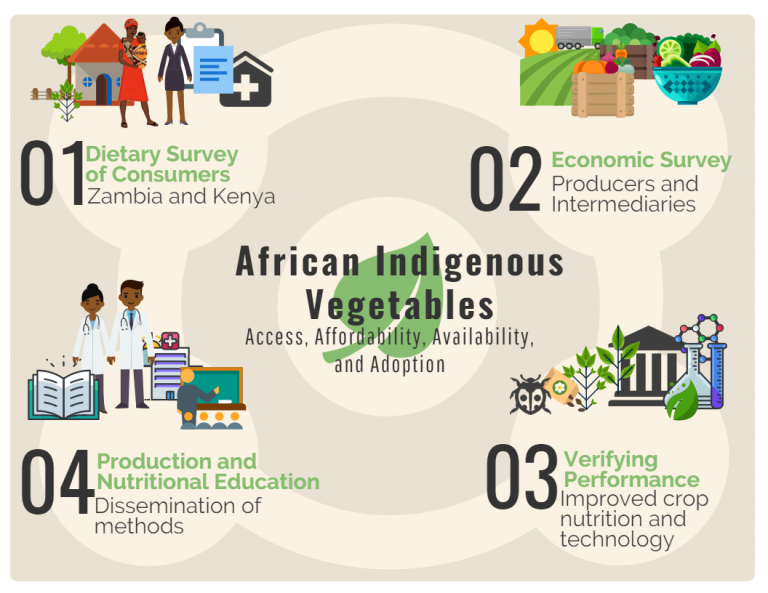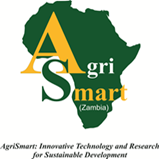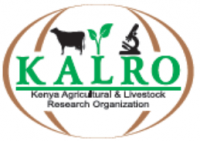African Indigenous Vegetables


Improving Nutrition with African Indigenous Vegetables
African Indigenous Vegetables (AIVs) have unrealized potential to improve the health status of at-risk populations. Working with influential organizations in Zambia, Kenya, and Tanzania we are identifying and addressing the most critical limiting factors on consumption of AIVs. Through the following activities, our overall goal is to increase access, affordability, availability, and adoption of AIVs

Dietary Survey of Aiv Consumers in Zambia and Kenya
- Identifying bottlenecks on consumer-side consumption of AIVs and nutritious foods
- Baseline data informing development of nutrition education intervention activities
- Quantifying consumption of AIVs before and after interventions activities to understand how consumption can be most efficiently improved
Economic Survey on Producers and Intermediaries in Zambia and Kenya
- Identifying limitations on production and distribution of AIVs to communities
- Informing production intervention activities to efficiently improve capacity of AIV suppliers
Verifying Performance of Improved Technology and Practices
- Conducting variety trials to verify performance of advanced AIV lines to reliably inform
production interventions - Comparing agronomic practices to understand the relative effectiveness of implementing pest management techniques, ultimately to instruct producers in production interventions
Production and Nutritional Education Interventions
- Disseminating improved production practices and educating on health and nutrition practices
- Intervention methods informed by survey results and technology validation studies
Current AIVs Included
- African Nightshade (Solanum spp.)
- African Spider Plant (Cleome gynandra)
- Amaranth (Amaranthus spp.)
- Moringa (Moringa oleifera)
- Roselle/Hibiscus (Hibiscus sabdariffa)
- Ethiopian Mustard (Brassica carinata)
- African Eggplant/ Garden egg (Solanum aethiopicum)
- Cowpea Greens (Vigna unguiculata)
Publications
2024. Yu, Z., H. Xu, R. Govindasamy, E. Van Wyk, B. Ozkan and J.E. Simon. An Analysis of Factors Influencing African Indigenous Vegetable Farmers’ Bargaining Power: A Case Study from Zambia. Journal of Agricultural Sciences 30(1):193-204. DOI: 10.15832/ankutbd.1239590
2023. Merchant, E.V., M. Odendo, N. Maiyo, R. Govindasamy, X.K. Morin, J.E. Simon and D.J. Hoffman. An evaluation of nutrition/culinary and production interventions using African Indigenous Vegetables on nutrition security among smallholder farmers households in Western Kenya. Front. Nutr. 10:1154423. doi:10.3389/fnut.2023.1154423
2023. Hu, S., J.E. Simon, M. Wang, Y. Wu, Y. Huang and Q.L. Wu. Kinkéliba (Combretum micranthum) leaf extract alleviates skin inflammation: In-vitro and in-vivo study. Molecules 28:1791. https://doi.org/10.3390/molecules28041791
2022. Merchant, E.V.; T. Fatima A. Fatima, N. Maiyo, V. Mutuku, S. Keino, J.E. Simon, D.J. Hoffman, and S.M. Downs. The Influence of Food Environments on Food Security Resilience during the COVID-19 Pandemic: An Examination of Urban and Rural Difference in Kenya. Nutrients 14, 2939. http://doi.org/10.3390/nu14142939
2022. Arumugam, S., Govindasamy, R., Simon, J.E., E. Van Wyk and B. Ozkan. Market outlet choices for African indigenous vegetables (AIVs): A socio-economic analysis of farmers in Zambia. J. Agricultural and Food Economics 10:28. DOI. https://doi.org/10.1186/s40100-022-00235-6
2022. Merchant, E.V., M. Odendo, C. Ndinya, N. Nyabinda, E. Onyango, N. Maiyo, S. Downs, D.J. Hoffman, and J.E. Simon. Barriers and facilitators of African Indigenous Vegetable preparation and consumption: a qualitative exploration. Frontiers in Sustainable Food Systems. 6(801527). https://doi.org/10.3389/fsufs.2022.801527
2022. Zivkovic A., E.V. Merchant, T. Nyawir, D.J. Hoffman, J.E. Simon, S. Downs. Strengthening vegetable production and consumption in a Kenyan informal settlement: a feasibility assessment of a sack garden intervention. Current Developments in Nutrition, nzac036. Doi. 10.1093/cdn/nzac036
2022. Mahoney, O., C. Melo, A. Lockhart, N. Cornejal, S. Alsaidi, Q.L. Wu, J.E. Simon, R. Juliani, T.M. Zydowsky, C. Priano, A. Koroch and J.A. Fernández Romero. Antiviral activity of Aframomum melegueta against severe acute respiratory syndrome coronaviruses type 1 and 2. South African Journal of Botany 146:735-739. DOI: /doi.org/10.1016/j.sajb.2021.12.010.
2021. Daba, T., A.D. Fall, D.S. Mbacké, A. Sarr, W. Lyu, Q.L. Qingl-Li, J.E. Simon, and E. Bassene. Rapid isolation of vitexin from leaves of kinkeliba, Combretum micranthum G. Don. Journal of Pharmacognosy and Phytochemistry 10(1):14-16. DOI:10.22271/phyto.2021.v10.i1a.13251
2021. Yuan, B., W. Lyu, F.F. Dinssa, J.E. Simon and Q.L. Wu. Free amino acids in African indigenous vegetables: analysis with improved hydrophilic interaction ultra-high performance liquid chromatography tandem mass spectrometry and interactive machine learning. Journal of Chromatography A: 1637: 461733 https://doi.org/10.1016/j.chroma.2020.461733
2020. Simon, J.E., S. Weller, D. Hoffman, R. Govindasamy, X.K. Morin, E.V. Merchant, F.F. Dinssa, E. van Wyk, D. Byrnes, M. Odendo, C. Ndinya, H.H.A. Mvungi, J. Ochieng, N. Maiyo, M. Mataa, J. Shindano, H.B. Moonga, J.S. Yaninek, Q.L. Wu, N. Nyabinda, V. Afari-Sefa. Improving Income and Nutrition of Smallholder Farmers in Eastern Africa using a Market-First Science-Driven Approach to Enhance Value Chain Production of African Indigenous Vegetables. J. Medicinally Active Plants 9(4):289-309.
2020. Ndinya, C., Dinssa, F., Simon, J.E., Nyabinda, N., Maiyo, N., Weller, S., Odendo, M., Onyango, E., Mwangi, M. and Makete, N. Assessment of Seed Quality of Selected African Leafy Vegetables Produced in Western Kenya using informal and semi-formal seed systems. J. Medicinally Active Plants 9(4):269-280.
2020. Mvungi, H.H.A., A. Laizer, P.J. Lukumay, J. Ochieng, G. Ngoteya, F. Dinssa, J.E. Simon, R. Govindasamy, C. Ndinya and M. Odendo. 2020. Profitability Analysis of Traditional African Vegetable Seeds Production in Kenya. J. Medicinally Active Plants 9(4):281-288.
2020. Govindasamy, R., Kelly, A., Simon, J.E., Van Wyk, E., Weller, S., Ramu, G., and Mbeweu, M. Postharvest handling, processing, value, and marketing of African indigenous vegetables: A case study from Zambia. Journal of Medicinally Active Plants 9(4):209-221.
2020. Govindasamy, R., Q. Gao, J.E. Simon, E. Van Wyk, S. Weller, G. Ramu and M. Mbeweu. An assessment of African Indigenous Vegetables grower’s production practices and the environment: a case study from Zambia. J. Medicinally Active Plants 9(3):195-208.
2020. Brindisi, L., E.V. Merchant, B. Eliver, J. Odhiambo, E. Night, T. Nyawir, N. Nyabinda, S. Weller, J.E. Simon and D. Hoffman. Comparative nutritional analysis between African Indigenous Vegetables grown by urban farmers and those available for purchase in Kibera, Nairobi, Kenya: A Case Study. J. Medicinally Active Plants 9(3):166-180.
2020. Ndinya, C., E. Onyango, F. Dinssa, M. Odendo, J.E. Simon, S. Weller, E. Thuranira; N. Nyabinda and N. Maiyo. Participatory variety selection of three African leafy vegetables in western Kenya. J. of Medicinally Active Plants 9(3):145-156.
2020. Odendo, M., C. Ndinya-Omboko, E.V. Merchant, N. Nyabinda, E. Minyatta-Onyango, N. Maiyo, D. Hoffman and J. E. Simon. Do preferences for attributes of African Indigenous Vegetable recipes vary between men and women? A case study from Western Kenya. J. Medicinally Active Plants 9(3):126-132.
2020. Arumugan, S., R. Govindasamy, J.E. Simon, E. Van Wyk, K. Chali, M. Mbewe, I. Siziya, S. Weller and X.K. Morin. African Indigenous Vegetables Production and Consumption Behavior of Farmers in Zambia: An Econometric Analysis. Technium Social Sciences Journal 8:220-228.
2020. Hwang, L., L.M Merja, J.E. Simon and H.R. Juliani. Developing New Natural Plant Products from the Spice Xylopia aethiopica from Ghana and Liberia. J. Medicinally Active Plants 9(1):14-20. https://scholarworks.umass.edu/jmap/vol9/iss1/3.
Partners








